Figure 5.
Spike-triggered averages. a, Top row: Normalized and mean-subtracted spatiotemporal STAs resulting for stimulation with dense noise at high contrast (qon = 80 Hz) and low contrast (qon = 40 Hz). Bottom row: Temporal modulation of excitatory and inhibitory integration. Lines of different width correspond to sections along the horizontal axis at t1 = 0, t2 = 40, and t3 = 100 ms before spike, as indicated above. b, Cells in the network with DI respond most to salient stimulus aspects. Top row: Activating a subset of receptor units to fire at increased rate (plain line: receptors 8–25, dashed line: receptors 14–18) results in selective responses. Middle row: Network response during stimulus presentation. While a narrow stimulus most strongly excites cells with a predictive field centered on the stimulus, wider stimuli evoke selective responses for cells centered close to the stimulus borders. Bottom row: Networks without divisive inhibition do not show this selectivity due to the lack of competition. c, Spatiotemporal STAs for cells in a network without divisive inhibition at high contrast. d, STAs for cells in a network with BC at high (left) and low contrast (right). e, STAs for cells in a network with LI at high (left) and low contrast (right).

